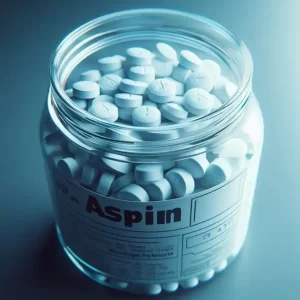How many fake clinical trials are killing patients?
- Early Biomarker for Multiple Sclerosis Development Identified Years in Advance
- Aspirin Found Ineffective in Improving Recurrence Risk or Survival Rate of Breast Cancer Patients
- Child Products from Aliexpess and Temu Contain Carcinogens 3026x Over Limit
- Daiichi Sankyo/AstraZeneca’s Enhertu Shows Positive Results in Phase III DESTINY-Breast06 Clinical Trial
- Mn007 Molecules Offer Potential for Combating Streptococcus pyogenes Infection
- Popular Indian Spices Banned in Hong Kong Over Carcinogen Concerns
- AstraZeneca Admits for the First Time that its COVID Vaccine Has Blood Clot Side Effects
- Was COVID virus leaked from the Chinese WIV lab?
- HIV Cure Research: New Study Links Viral DNA Levels to Spontaneous Control
- FDA has mandated a top-level black box warning for all marketed CAR-T therapies
- Can people with high blood pressure eat peanuts?
- What is the difference between dopamine and dobutamine?
- How long can the patient live after heart stent surgery?
How many fake clinical trials are killing patients?
We often see that there are problems with the repeatability of some basic research, or that a certain picture is suspected of being fake, etc. Academic anti-counterfeiting expert Elisabeth Bik has also become famous in recent years for finding suspicious pictures in a large number of basic researches with “sharp eyes”.
All kinds of basic research falsification have also attracted the attention of the academic community to the problem of “paper factories”, such as third-party “ghost writing” papers, which are sold to researchers and doctors who have “just needed” publications.But academic fraud and paper factories are by no means limited to basic research. A news analysis in “Nature” on July 18, 2023 focused on the issue of clinical trial fraud or unreliability :

When discussing whether a certain drug can cure a certain disease, randomized clinical trials can be said to be a golden sign, which is also reflected in the evidence reliability standards of evidence-based medicine:

RCT—randomized controlled trials, randomized clinical trials are the most reliable single evidence, and higher-level evidence, such as comprehensive analysis, is also based on the analysis of multiple RCTs.
Unfortunately, unreliable RCTs are probably more common than many people realize . And how can evidence-based medicine work when RCT itself is unreliable ??
Some “miracle medicines” in the COVID epidemic will also use the banner of “RCT proved to be effective”. The news report of “Nature” cited the example of ivermectin. Many anti-vaccine conspiracy theorists highly advocate the use of ivermectin to treat the COVID, and they will also cite examples of clinical trials conducted in Thailand.
However, there are many problems in those studies that claim that ivermectin is effective, and some have been withdrawn. A Cochrane review pointed out that more than 40% of the randomized clinical trials of ivermectin in the COVID were unreliable .
The problem of RCT unreliability did not appear after the COVID, let alone limited to the COVID. The “Nature” report mentioned an anesthesiology expert John Carlisle, who is the editor-in-chief of the “Anaesthesiology” journal. Taking advantage of the “convenience of his position”, Carlisle asked the author for the original data of the relevant RCT (the personal information of the specific subjects was anonymized to protect privacy).
In the three years since 2017, he has requested the original data of more than 150 RCT studies, and compared the analysis of the authors in the papers, he found that 44% of them had problems: problems with statistical analysis, calculation errors, data duplication, etc.
26% of the questions were so serious that it was impossible to determine whether the conclusions were reliable. For these RCTs with serious problems, Carlisle calls them “zombie experiments” because they look like serious research on the surface, but in fact they cannot provide reliable information at all, and may even provide false information!
To find out “zombies” is extremely dependent on careful inspection of the original data. When the author did not provide the original data of RCT, Carlisle could only find 2% of the studies with problems, and 1% could be judged as “zombies” (serious problems that make the conclusions unreliable).

But not all journals will ask to provide original data, and even if they provide original data, most journals can’t really check it carefully-this work is too energy-intensive.
The chances of a “zombie study” being published are not small . Most of the “zombie studies” that Carlisle found himself rejected as the editor-in-chief are now published in other journals, and some have changed the data.
As mentioned above, the results of randomized clinical trials are medical information that we value very much. When 20-30% of RCT results are unreliable, it is very likely to exaggerate or even fabricate the effectiveness of some drugs or treatment programs .
Why is it an exaggeration rather than an underestimation of the effectiveness, because the publication of the paper itself has a tendency to positive results, and in many cases, the test results have a chance to be published only if they are effective. Even if it is a fake, the task of publishing a paper can only be completed if the fake is effective.
At the level of evidence-based medicine, the conclusions based on the comprehensive analysis of multiple clinical trials will be more reliable than a single clinical trial. But what if several of the multiple clinical trials are unreliable?
The “Nature” article gave the example of tranexamic acid. This hemostatic drug is used to treat postpartum hemorrhage, the leading cause of death during childbirth. Unfortunately, the field of maternal health currently appears to be the hardest hit area of low clinical trial reliability .
In 2021, a comprehensive analysis based on 36 RCTs found that the effectiveness of tranexamic acid in preventing postpartum hemorrhage immediately after caesarean section was as high as 60%.
After pooling 36 RCTs, the number of subjects in this analysis was as high as 10,000. Multiple clinical trials, large numbers of people, significant efficacy, everything looks good, doesn’t it?
But this year, a large-scale clinical trial in the United States with as many as 11,000 subjects showed that tranexamic acid had no significant effect on preventing postpartum hemorrhage. Why is there such a face-slapping contrast?
In fact, among the previous 36 RCTs, only one was a French multi-center study with more than 4,000 subjects, and the effectiveness was only 16%.
The remaining 35 single-center small studies have a combined effectiveness of 93%. It is these small single-center studies that may not be reliable that have driven the surprising effectiveness of tranexamic acid in preventing postpartum hemorrhage.
This is probably also a relatively common phenomenon in “false” randomized clinical trials: everyone refers to a certain research result to make up a story .
From the perspective of published papers, it is easy to understand why this phenomenon occurs. One, positive results are easier to publish, so you have to “make up” a clinical trial that is positive. Second, you can’t make it too outrageous. For example, you can live forever if you take a certain vitamin. This will easily attract the attention of journal editors and reviewers, resulting in disclosure.
The best way is to look at the clinical trials with positive results published by others, and make up stories based on similar results. Such escorts with similar results in the past are more likely to be recognized by journals .
However, when a large number of “story-making” clinical trials are published, it will affect our scientific judgment. Like the prevention of postpartum hemorrhage with tranexamic acid, it was originally a study, and its effectiveness was weak and not necessarily reliable.
A bunch of studies followed the story, creating the false impression that the effectiveness was repeatedly verified and very high.
Even if it is not serious enough to make an ineffective drug overly cosmetic to be effective, copying and pasting strictly according to a certain study will result in a larger sample size, making the original low-reliability study due to the small sample size look extremely reliable.
The important basis for us to choose effective medical solutions and drugs is the results of randomized clinical trials, or the comprehensive analysis based on the results of multiple RCTs. When these foundations become empty due to false trials, we are also likely to choose the wrong treatment options, drugs, and suffer from it.
Looking back on the development of COVID drugs in the past few years, we can see many suspicious RCTs.
A well-known one is proxalutamide, which was originally claimed to be highly effective in both mild and severe cases in clinical trials in Brazil. But in the experiment, the fatality rate of the control group was close to 50%, which was ridiculously high.
Fortunately, this drug is not on the market. In addition to deceiving investors, the harm is still “preventable and controllable”. But other COVID-19 drugs with dubious clinical trials are less fussy .
Azvudine’s listing history is a master of unreliable research. When the drug was launched, the most publicized was a clinical trial based on 31 people, showing that azvudine was effective regardless of severity.
Then there are phase III clinical trials that have not been officially published so far, showing accelerated nucleic acid negative conversion, etc.
Each phase III clinical trial recruits only more than 300 people, and the effectiveness is incredible.
Then there are some real-world studies that claim to prove its effectiveness in practice-although there are various contradictory data points in these studies using the same batch of raw data (suspected to be fake!}
Choosing to believe these dubious clinical studies, ignoring the doubts, and even dispelling doubts, led to the fact that the most widely used COVID drug in the first wave of the epidemic in China is a “pseudo-antiviral drug” that has no credible data and cannot be effective in principle. There may be millions of people who not only do not receive effective antiviral treatment, but are also threatened with unnecessary side effects.
This is where “zombie experiments” are more worrisome than falsification of basic research papers. The dissertation factory wholesales basic dissertations, which mainly affect the academic field. But when storytelling involves clinical trials, especially randomized clinical trials (some of which involve paper mills), that’s really close to murder.
We need to reduce the emergence of ” zombie experiments” at the source by cracking down on paper factories and changing the unreasonable academic evaluation system . But in the foreseeable future, the pressure on researchers to publish papers will not disappear, and academic journals are also very motivated to help researchers publish papers-this can increase influence for journals, and there are also direct economic benefits, and there may be greater economic/capital drivers behind “successful” clinical trials.
Therefore, unreliable or even falsified clinical trials and related papers will not disappear. The real key is how to prevent the influence of these suspicious clinical trials from spreading, and prevent specific medical practices from being based on unreliable “zombie data”. This requires us to have more scientific and rational speculation, and requires medical experts and drug regulatory agencies to show the independence they should have, and become the Great Wall between the public and poison .
When faced with drugs that are obviously insufficient or even have sufficient evidence to show that they are ineffective and harmful, if academicians, experts and regulatory agencies help to read the press release of the management, it will not only expand the harm of false clinical trials, but also become the soil for the birth of such “zombies”.
How many fake clinical trials are killing patients?
(source:internet, reference only)
Disclaimer of medicaltrend.org
Important Note: The information provided is for informational purposes only and should not be considered as medical advice.



